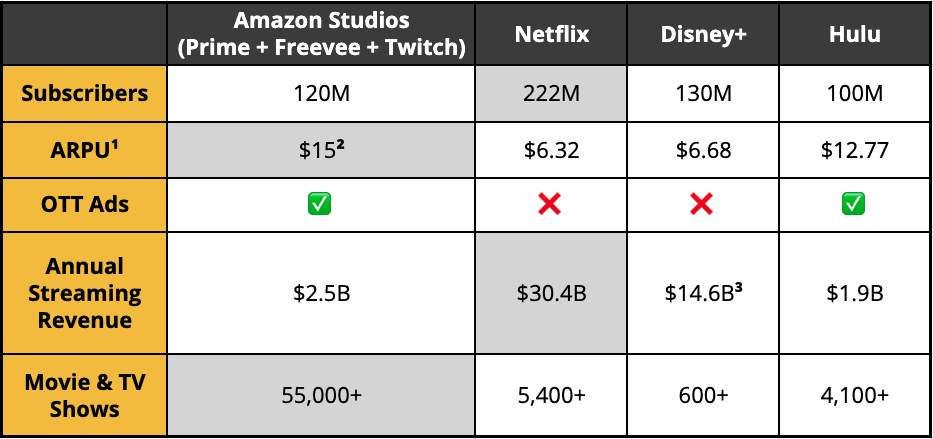Fast Facts: Amazon & the Movie Industry
Tinsel-town has turned its attention to streaming — Warner Brothers and Discovery have completed a $43B merger and Amazon has snatched up MGM Studios for $8.5B.
So, what’s the deal?
Has streaming completely changed the movie industry forever? Yes, and…
The competition is stiffer than ever.
CNN+ shut down after just 1 month of being live, and Netflix is exploring an ad-supported channel to capitalize on a potential $9B in missed revenue as it comes off the heels of a Q1 that saw 200k subscribers leave the platform — another 2m are expected to leave in Q2.
Why is Amazon choosing now, the most competitive time ever in the streaming wars, to acquire MGM?
Let’s take a brief trip down memory lane…
Amazon’s Streaming History
Amazon’s interest in movies and video content has always been a key aspect of its business …
- 1998 — IMDb is acquired as a lead generator for sales of hard copy movies (VHS and DVDs)
- 2006 — Prime Video launches and is included with all memberships
- 2010 — Amazon Studios takes off to produce in-house content (beating Netflix to the punch of in-house content creation by 3 years)
- 2019 — IMBb TV launches as a FAST service (Free, Ad-Supported Television) for non-Prime-holding viewers, expanding its sphere of influence and capitalizing on yet another OTT (Over-The-Top) advertising channel
- 2022 — IMDb TV is rebranded as Amazon Freevee to better reflect the platform’s value and to differentiate itself from the IMDb app.
If Amazon is already making its own content, why does it want to acquire more?
Establishing Dominance
- Prime Video = 26,000 movies titles and 2,700+ shows
- Freevee = 3,000+ titles, with a 70% bump in exclusive Originals by the end of ‘22
- MGM = 4,000+ movies and 17,000+ TV shows
It’s a combination of quantity and quality that Amazon is after — according to Protocol, MGM holds 4,000+ movies including franchises like Rocky, James Bond, The Addams Family, and The Pink Panther, as well as another 17,000+ TV shows including series like The Handmaid’s Tale, Fargo, and Vikings.
This would bring Amazon’s total number of movies and shows to a whopping 55,000 with an emphasis on quality titles that it can spin-off and expand on via Amazon Studios.
As a comparison, Netflix only offers 1/10th of that — 5,400 titles (3,600+ movies and 1,800 TV shows) — with no ad revenue (yet). Disney+ has a mere 600+ titles but also leverages theme parks and lucrative merchandising from massive fan universes like Marvel and Star Wars.
It’s likely that the MGM catalog will be split amongst Prime Video (to increase the perks of membership) and send a slew of titles to Freevee, where 120M subscribers see OTT advertisements.
So how do these streaming titles stack up in terms of numbers? So glad you asked!
Buy The Numbers
Amazon’s closest direct competitor in streaming is Hulu, who leads in OTT devices (think SmartTVs like Roku which is owned by Hulu), but Amazon is a close 2nd — 1 in 3 OTT devices are Amazon FireSticks.
That statistic can’t be underscored enough — the new Amazon FireStick interface is a visual experience, a virtual gateway, to other streaming services. From the home screen, the user has the view of seeing what’s popular across multiple platforms, simultaneously, all while Amazon serves OTT banners. It’s brilliant.
So how does one smash the competition? Buy the numbers — Amazon’s incredible arsenal of content will continue to be a game changer as it is now hot on the heels of Netflix in terms of subscriber count.

2Figure reflects viewers only (does not include marketplace revenue)
3Includes Film & TV operations
Thankfully for Amazon, it doesn’t need to compete directly with Netflix — who hosts all of its servers via AWS (Amazon Web Services) to the tune of $115M annually. And it has other sources of revenue, like Disney, in the form of sales, memberships, AWS, cloud computing, and more.
The Bottom Line
More content — and quality of it — attracts more viewers, and more eyeballs on ads means more revenue.
Amazon is seemingly on a quest to be the Library of Alexandria when it comes to content (in fact, that’s the inspiration behind the name Alexa!), but the purchase wasn’t merely just for the content, rather the ad revenue.
So if you’re a business that’s looking to generate more revenue in the form of OTT content, we’re here to help. Reach out to us HERE.


